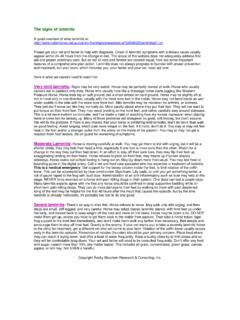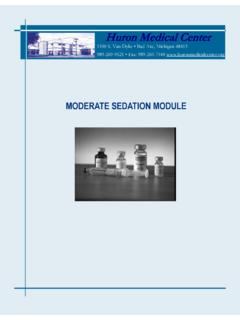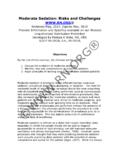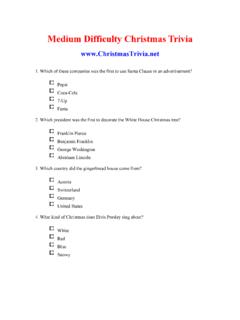Transcription of What Breaks a Leader: The Curvilinear Relation Between ...
1 PERSONALITY PROCESSES AND INDIVIDUAL DIFFERENCES. What Breaks a Leader: The Curvilinear Relation Between assertiveness and Leadership Daniel R. Ames and Francis J. Flynn Columbia University The authors propose that individual differences in assertiveness play a critical role in perceptions about leaders. In contrast to prior work that focused on linear effects, the authors argue that individuals seen either as markedly low in assertiveness or as high in assertiveness are generally appraised as less effective leaders. Moreover, the authors claim that observers' perceptions of leaders as having too much or too little assertiveness are widespread. The authors linked the Curvilinear effects of assertiveness to under- lying tradeoffs Between social outcomes (a high level of assertiveness worsens relationships) and instrumental outcomes (a low level of assertiveness limits goal achievement). In 3 studies, the authors used qualitative and quantitative approaches and found support for their account.
2 The results suggest that assertiveness (and other constructs with nonlinear effects) might have been overlooked in research that has been focused on identifying what makes a leader rather than on identifying what Breaks a leader. Keywords: assertiveness , leadership, interpersonal relations , individual differences, Curvilinear effects The study of lives and personalities has long been concerned but that the nature of this link has proven elusive for researchers, with questions of which types of people emerge as effective in part, because their focus has been on what makes leaders rather leaders and why (for recent reviews, see Hogan & Kaiser, 2005; than on what Breaks them. Most researchers conducting leadership Judge, Bono, Ilies, & Gerhardt, 2002). In this wide-ranging liter- studies have investigated positive, linear determinants and have ature, a pattern of seemingly contradictory results revolves around attempted to specify which personality characteristics are present assertiveness , which is a person's tendency to actively defend, in attributions of successful leadership.
3 Far fewer studies have pursue, and speak out for his or her own interests. Some scholars identified attributes associated with ineffective leadership. This have found that leadership emergence and effectiveness are posi- make-versus-break distinction would not mean much if leadership tively related to high- assertiveness constructs, such as dominance, perceptions were symmetrical that is, if the concerns that appear aggressiveness, and nondeference ( , Bass, 1990; Gough, 1990; in everyday descriptions of leader weaknesses were simply the Hills, 1984; Lord, De Vader, & Alliger, 1986). However, leader- opposite of those characteristics associated with leader strengths. ship has also been positively linked to low- assertiveness con- In the present article, we suggest that the concerns that dominate structs, such as self-sacrifice, cooperativeness, and consideration perceived weaknesses are not the mirror image of strengths and ( , Bass, 1990; De Cremer & van Knippenberg, 2004; Guilford, that this difference can clarify the role of an overlooked compo- 1952; Judge, Piccolo, & Ilies, 2004; van Knippenberg & van nent of leadership: assertiveness .)
4 Knippenberg, 2005). Given these disparate effects, a reasonable We suspect that the perceived shortcomings of leaders may observer may suspect that the overarching link Between leadership often revolve around chronically low levels of assertiveness or and assertiveness is not meaningful, is extremely situation specific, chronically high levels of assertiveness . High levels of assertive- or, perhaps, is unknowable. But is there an integrated story that can ness may bring instrumental rewards and short-term goal achieve- reconcile these past results and shed new light on who is seen as ment but can be costly when relationships fray or fail to take root. an effective leader and why? Or, to put it more generally: How In contrast, low levels of assertiveness may bring social benefits does assertiveness matter to leadership, if it matters at all? but can undermine goal achievement. Thus, increasing levels of We believe that individual differences in assertiveness matter assertiveness may often entail a trade-off Between social costs and greatly to observers' perceptions of leaders and potential leaders instrumental benefits Between getting along and getting one's way.
5 However, we do not think these trade-offs offset one another Daniel R. Ames and Francis J. Flynn, Management Division, Columbia or cancel each other out. Below some level of assertiveness , Business School, Columbia University. instrumental costs loom large, and leaders may primarily be seen We thank Cameron Anderson for comments on the article. We also as ineffective. Above some level of assertiveness , social costs thank Jenn Hu, Dora Kanellopoulos, Julia Ostrov, and Shelley Trone for help with coding. loom large, and leaders may primarily be seen as antagonistic. Correspondence concerning this article should be addressed to Daniel R. Accordingly, we predicted a Curvilinear Relation Between asser- Ames, Columbia Business School, Columbia University, 707 Uris Hall, tiveness and overall leadership perceptions, such that above and 3022 Broadway, New York, NY, 10027. E-mail: below certain levels, leaders tend to be seen as less effective.
6 Journal of Personality and Social Psychology, 2007, Vol. 92, No. 2, 307 324. Copyright 2007 by the American Psychological Association 0022-3514/07/$ DOI: 307. 308 AMES AND FLYNN. Our approach and results make several potential contributions to be viewed negatively because their behavior seems hostile and the literatures of personality and leadership. Specifically, we call offensive ( , they cannot get along); those who lack assertiveness attention to assertiveness as a critical component of leadership may be seen as weak leaders because they fail to take charge in effectiveness. More generally, this work suggests that the impact situations that require initiative and conviction ( , they cannot of individual differences on leadership and perhaps on basic get their way). Although many potential leaders may be seen as interpersonal relations may be underestimated to the extent that having too little or too much assertiveness , we did not expect this nonlinear associations have been overlooked (cf.)
7 Simonton, 1995). to be the case with most other commonly discussed attributes of leaders. Other attributes, such as intelligence, charisma, or consci- assertiveness : A Behavioral Spectrum entiousness, would likely be viewed as weaknesses only when targets possessed them in limited amounts (but see Simonton, assertiveness is viewed as a dimension describing people's 1985). tendency to speak up for, defend, and act in the interest of them- Although we anticipated that over- and underassertiveness selves and their own values, preferences, and goals1 (cf. Costa & would frequently be cited as weaknesses, we did not expect that McCrae, 1992; Wilson & Gallois, 1993). Assertive behaviors can references to moderate assertiveness would similarly dominate be both proactive ( , vocalizing needs) and reactive ( , de- discussions of leadership strengths. Part of the reason for this fending against imposition), both verbal ( , articulating clear asymmetry may be that assertiveness is not as salient at moderate demands) and nonverbal ( , displaying annoyance), and both levels.
8 Instead, in the right range, assertiveness may fade into the local or immediate ( , a face-to-face disagreement) and diffuse background, allowing other attributes with positive, linear rela- or prolonged ( , influence tactics over time). tions with leadership to become more salient. In causal terms, a Some scholars have portrayed certain behaviors as occupying moderate level of assertiveness may be a background condition: a various points on an assertiveness continuum ranging from pas- necessary but insufficient cause of perceived leadership. Like salt sivity and submissiveness to aggressiveness and hostility ( , in a sauce, too much overwhelms the dish; too little is similarly Wilson & Gallois, 1993). As we explored it in Study 1, everyday distracting; but just the right amount allows the other flavors to use of the term appears to reflect this view, with assertiveness dominate our experience. Just as food is rarely praised for being labels attached to a wide range of behavioral levels.
9 Thus, low perfectly salted, leaders may somewhat infrequently be praised for assertiveness may refer to showing unwarranted deference, high being perfectly assertive. assertiveness may refer to belligerently pursuing goals, and mod- erate assertiveness may refer to defending against imposition and Instrumental and Social Consequences of assertiveness actively making legitimate claims. We adopt this dimensional view in the present article. Highly assertive people often get their way, at least in terms of short-run instrumental benefits. In organizations, assertive people tend to be seen by others as more powerful than passive employ- assertiveness and Perceptions of Leaders ees, and they tend to adopt more structurally advantageous posi- In impression formation, people attend closely to information tions in social networks. In the domain of interpersonal exchanges, about assertiveness , showing relatively high levels of observer assertive behavior, such as an extreme opening offer in a negoti- observer and observer target agreement (John & Robins, 1993; ation and a reluctance to make concessions, can dramatically Paunonen, 1989; Schmidt Mast, Hall, Murphy, & Colvin, 2003).
10 Increase instrumental outcomes ( , De Dreu, Weingart, &. One related dimension, extraversion, has been identified by nu- Kwon, 2000; Galinsky & Mussweiler, 2001). merous scholars as the most observable personality trait ( , Although a high level of assertiveness may entail instrumental Kenny, 1994). Another aspect of assertiveness , competitiveness, benefits, it often carries social costs. Assertive people tend to be often plays a key role in impression formation. Several researchers ( , De Bruin & Van Lange, 1999; Wojciszke, Bazinska, & 1. Jaworksi, 1998) have found that perceivers are more strongly It is worth recognizing the correspondence Between assertiveness and constructs featured in models of personality, such as extraversion in the Big drawn to information about a target's competitive motives than to Five personality dimension models ( , Costa & McCrae, 1992; John &. his or her intelligence. Work on leadership perceptions has like- Srivastava, 1999) and agency or communion in circumplex models ( , wise underscored the importance of assertiveness .)















